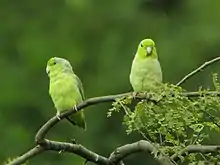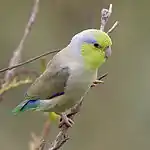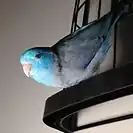Pacific parrotlet
The Pacific parrotlet (Forpus coelestis), also known as Lesson's parrotlet or the celestial parrotlet, is a species of small parrot in the family Psittacidae.
| Pacific parrotlet | |
|---|---|
 | |
| in Ecuador | |
| Scientific classification | |
| Kingdom: | Animalia |
| Phylum: | Chordata |
| Class: | Aves |
| Order: | Psittaciformes |
| Family: | Psittacidae |
| Genus: | Forpus |
| Species: | F. coelestis |
| Binomial name | |
| Forpus coelestis (Lesson, 1847) | |
Description

Pacific parrotlets (Forpus Coelestis) are a small green parrot originating from South America. They are 11–14 centimetres (4.3–5.5 in) long and typically weigh 30+ grams. Wild Pacific parrotlets are green with a dusty grey cast over the body with a nice bright green mask and a pinkish beak with pinkish grey legs and feet. Pacific parrotlets are sexually dimorphic (You can sex them just by looking at them) with males sporting beautiful blue on the wings. That blue can vary in intensity from a bright cobalt blue to a pale almost lavender shade of blue on American birds and be almost non existent on marbled birds only being visible on the underside of the wing right on the joint. Male parrotlets also have blue streaks behind the eyes which is often referred to as "eyeshadow" as well as blue rumps. Female parrotlets have no blue on the wings whatsoever but can have blue eye streaks as well as a blue rump. Parrotlets are often referred to as pocket parrot because of their size but are known for their larger than life personalities and feisty attitudes. They are solitary birds in captivity due to their aggressive behavior towards other birds unless they are in a large enclosure to get away from one another so it is not suggested to keep more than one together unless they have space and never put them with other types of birds because they will attack.
Although the base (wild) color of parrotlets is green they also come in a rainbow of mutations including: American Yellow, Green Marbled, American Yellow Marbled, Green Fallow, Green Fallow Marbled, American Yellow Fallow, American Yellow Marbled Fallow, Blue, American White, Blue Marbled, American White Marbled, Blue Fallow, American White Fallow, Blue Marbled Fallow, American White Marbled Fallow, Turquoise, American Turquoise, Turquoise Marbled, American Turquoise Marbled, Turquoise Fallow, American Turquoise Fallow, Turquoise Fallow Marbled, American Turquoise Fallow Marbled, Grey, American Grey, Grey Marbled, American Grey Marbled, Grey Fallow, American Grey Fallow, Grey Fallow Marbled, American Grey Fallow Marbled, Albino, Lutino Creamino, Cinnamon, Misty, Dark Factor, and Pied. There is no such thing as dilute in parrotlets and pastel was an incorrect term used for edging on the feathers and wings but the correct term is Marbled.
Distribution and Habitat
Wild Pacific parrotlets are native to western Ecuador and northwestern Peru.[2][3] Most common in dry habitats such as the desert and deciduous forest, but have spread into humid areas in response to deforestation.[4] Pacific parrotlets have also been reported in the middle Marañón valley.[3] In 2014 a small flock of Pacific parrotlets was reported near the Rio Mataje in Nariño, southwestern Colombia.[3]
They are abundant across their range; populations are relatively undisturbed by human activity.[5] Pacific parrotlets are found living in flocks from 40 to 50, on the borders of W lowlands and foothills, woodlands, shrubby clearings, gardens, parks, and crops (Restall & Freile, 2019, p. 208).[6] Pacific parrotlets typically live in subtropical or tropical dry forest, subtropical or tropical moist lowland forest, subtropical or tropical dry shrubland, and heavily degraded former forest. Pacific parrotlets are non-migratory, meaning they stay in the same area year-round.[2]

Conservation
The Pacific parrotlet is currently listed as Least Concern by the IUCN Red List.[1] The number of mature individuals in the wild is not known, but population size seems to be stable.
Behavior

Social
Pacific parrotlets are found living in flocks from 40 to 50 (Restall & Freile, 2019, p. 208).[6] Calls are high-pitched and rapid "tchit"; in flock situations this produces a constant chattering.[8][9] In captivity they are best kept alone as they are very aggressive toward other birds and often fight and even kill one another or other types of birds.
Reproduction
Pacific parrotlets are very protective of their eggs and chicks. Each clutch has 4-6 white eggs, which are incubated for an average of 18 days. In the wild they nest in tree cavities or on fence posts.[2] They have also been observed to nest in abandoned nests of necklaced spinetails and pale-legged horneros.[5]
Aviculture
This species is not very common in pet stores and is valued by breeders. Its normal price range is $250 all the way up to US$1200. Since 1930 the U.S. has had an established breeding population in captivity, before CITES laws preventing importing wildlife from foreign countries. In the wild, the average lifespan for Pacific parrotlets is 10.4 years.[10] Captive Pacific parrotlets can be expected to live up to 25 years[2] with good care, proper breeding, and regular veterinary examinations, although individuals may have shorter or longer life spans due to poor breeding practices.
Pacific parrotlets, like many larger parrot species, can learn to "speak," or mimic, though their "voices" are not as clear as larger birds. Their vocabulary is relatively limited compared to larger parrots.
The species is well known among parrotlet breeders and owners as being feisty and curious despite their small size.[11]
 Female blue and male green/wild-type
Female blue and male green/wild-type Male yellow mutation
Male yellow mutation_-AFA_show_bird-8a.jpg.webp) Male wild-type and female American white/dilute blue
Male wild-type and female American white/dilute blue Two male wild-types
Two male wild-types Female wild-type
Female wild-type
References
| Wikimedia Commons has media related to Forpus coelestis. |
- BirdLife International (2012). "Forpus coelestis". IUCN Red List of Threatened Species. 2012. Retrieved 26 November 2013.CS1 maint: ref=harv (link)
- "Celestial or Pacific Parrotlet, Lesson's Parrotlet, Forpus coelestis | Beauty of Birds". www.beautyofbirds.com. Retrieved 2019-03-08.
- Brinkhuizen, D.M.; Seimola, T. (October 2014). "First record of Pacific Parrotlet Forpus coelestis in Colombia" (PDF). Conservación Colombiana. 21: 30–32.
- Collar, N., P. F. D. Boesman, and G. M. Kirwan (2020). Pacific Parrotlet (Forpus coelestis), version 1.0. In Birds of the World (J. del Hoyo, A. Elliott, J. Sargatal, D. A. Christie, and E. de Juana, Editors). Cornell Lab of Ornithology, Ithaca, NY, USA. https://doi.org/10.2173/bow.pacpar2.01
- "Pacific Parrotlet - Introduction | Neotropical Birds Online". neotropical.birds.cornell.edu. Retrieved 2019-03-11.
- Restall, R. L., & Freile, J. F. (2019). Birds of Ecuador. London: Helm.
- https://ebird.org/map/pacpar2?env.minX=-82.0836340238823&env.minY=-17.0033684151375&env.maxX=-71.303850614448&env.maxY=2.23102405692696
- https://www.parrots.org/encyclopedia/pacific-parrotlet
- Schulenberg, T., Stotz, D., Lane, D., Neill, J., Parker, T. & Egg. (p. 172, 2010). Birds of Peru : Revised and Updated Edition. Princeton: Princeton University Press.
- https://eol.org/pages/1178011
- "They May Be Small, But Parrotlets Have a Big Bird Personality". The Spruce Pets. Retrieved 2019-03-08.
